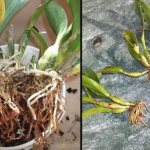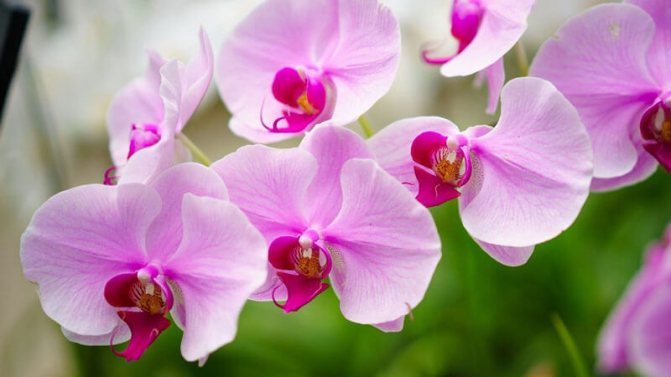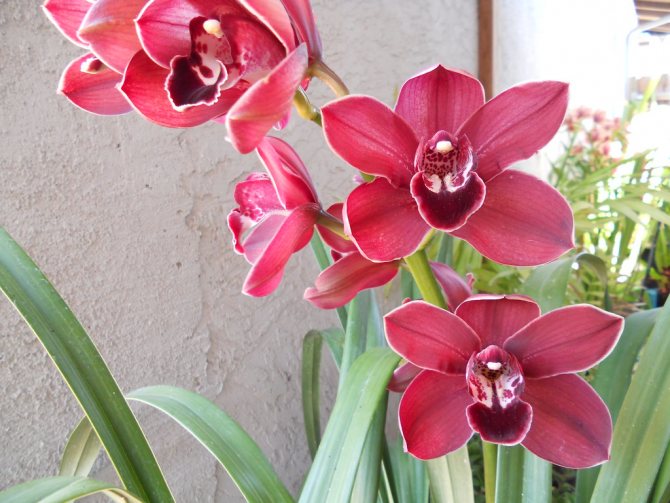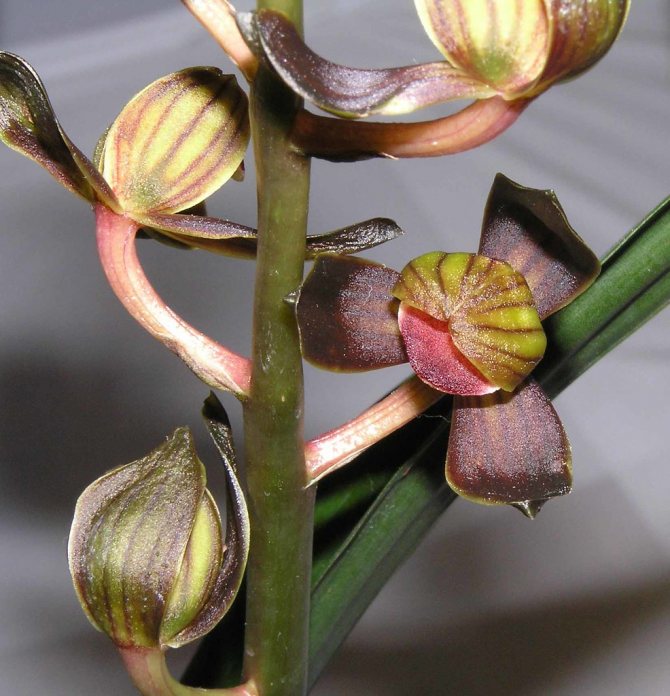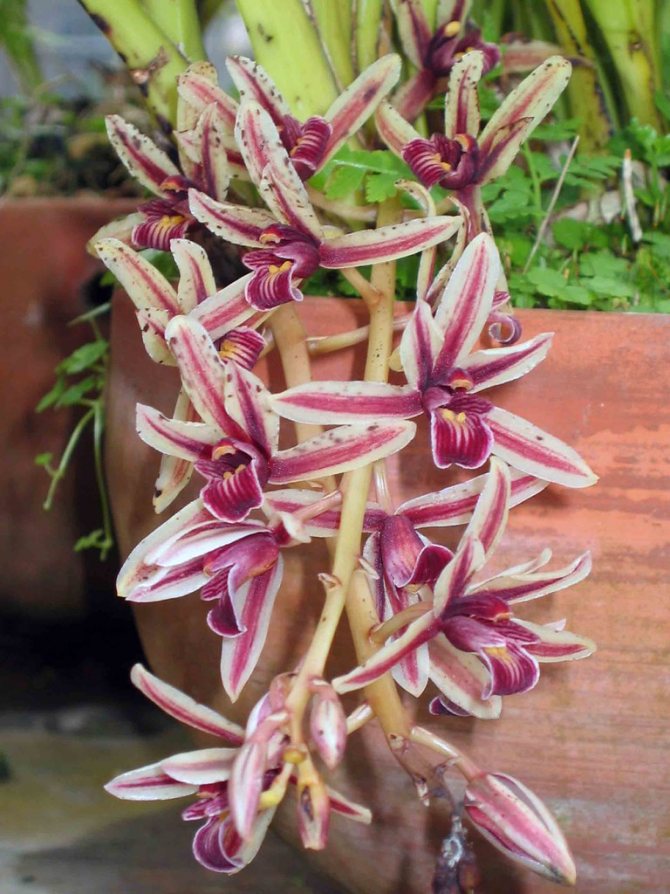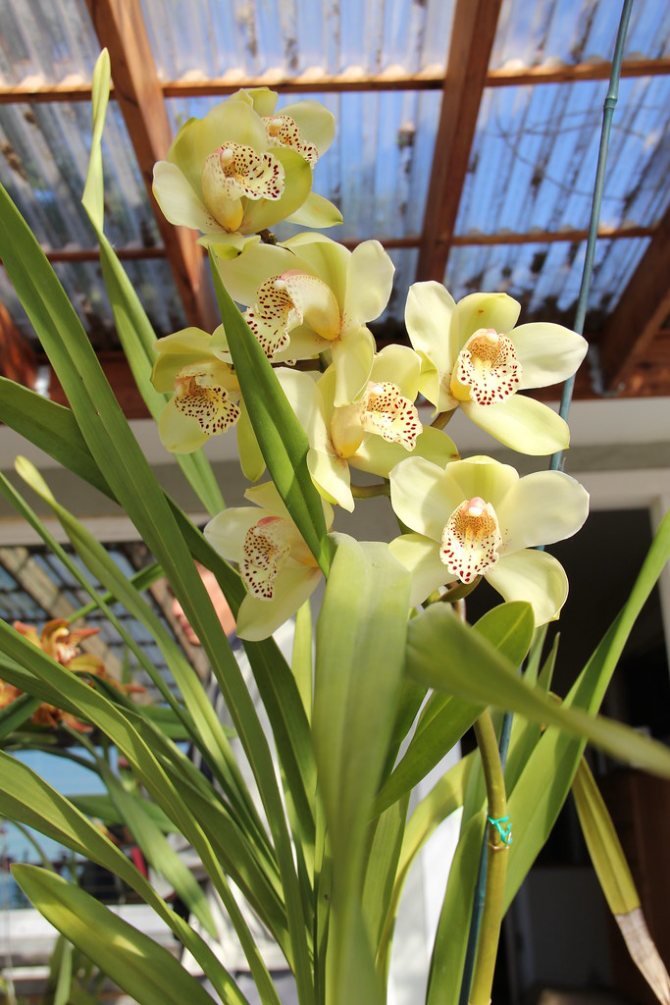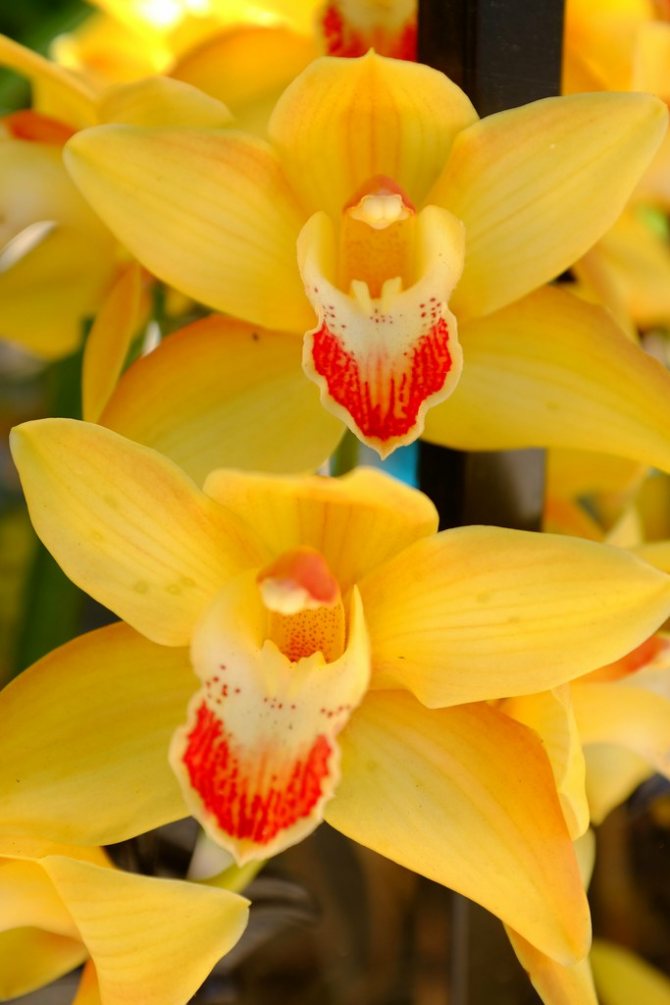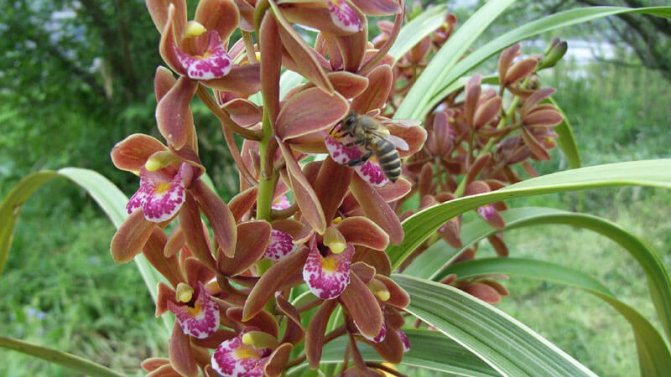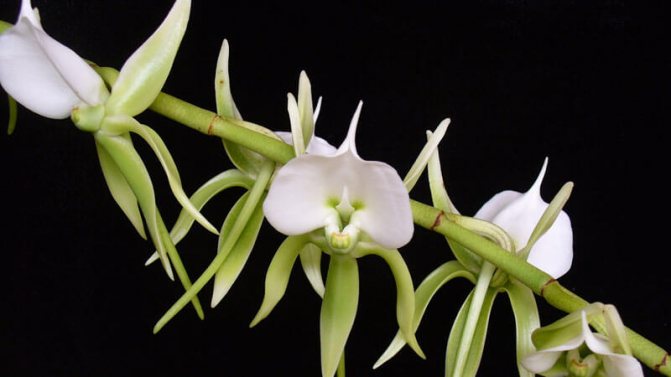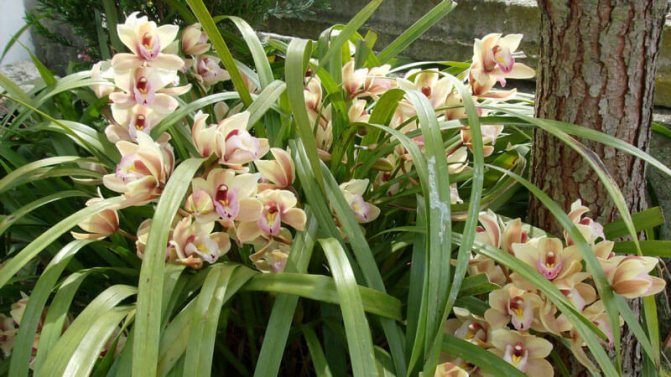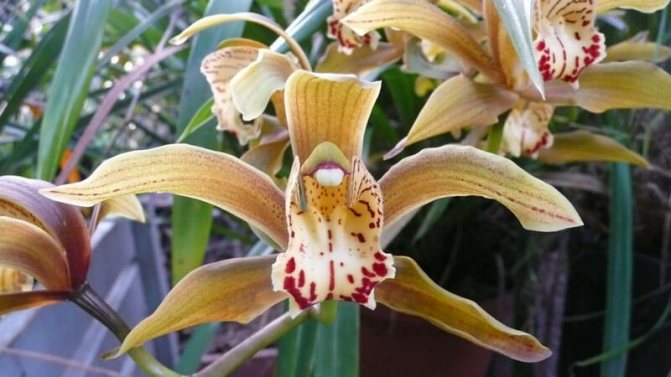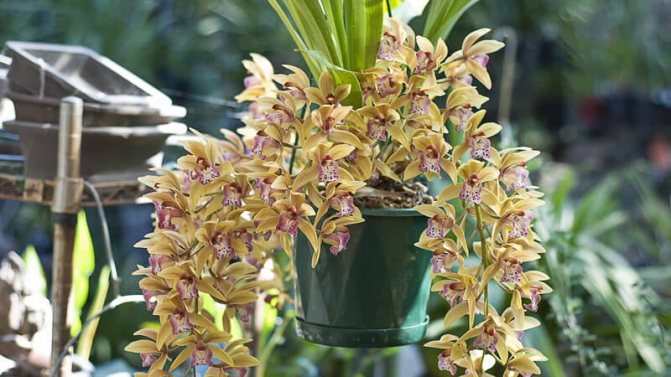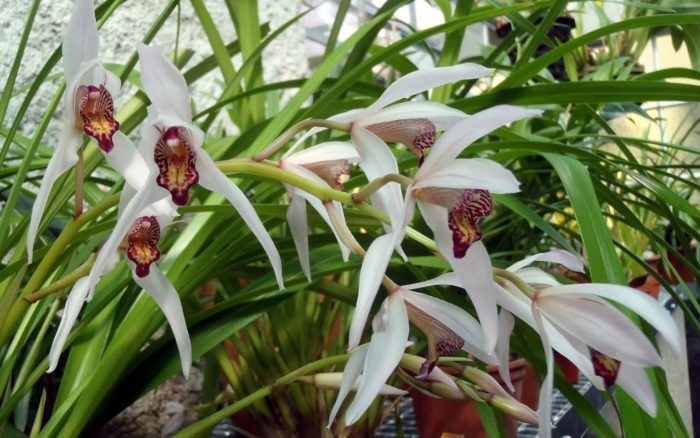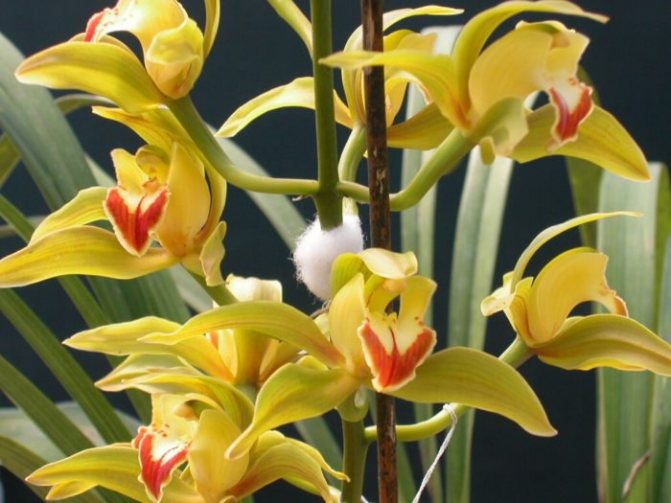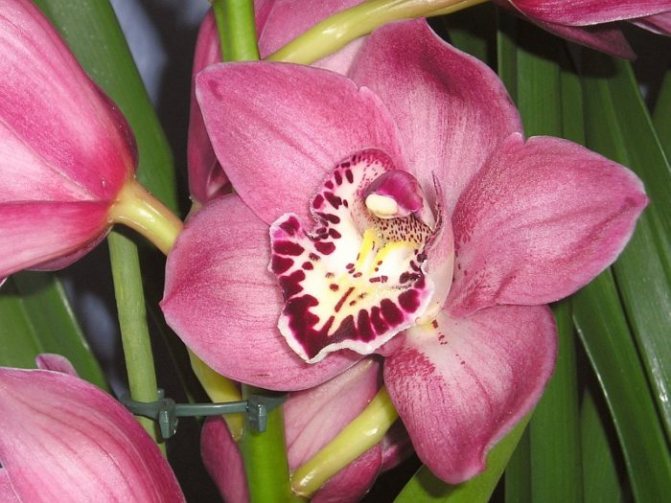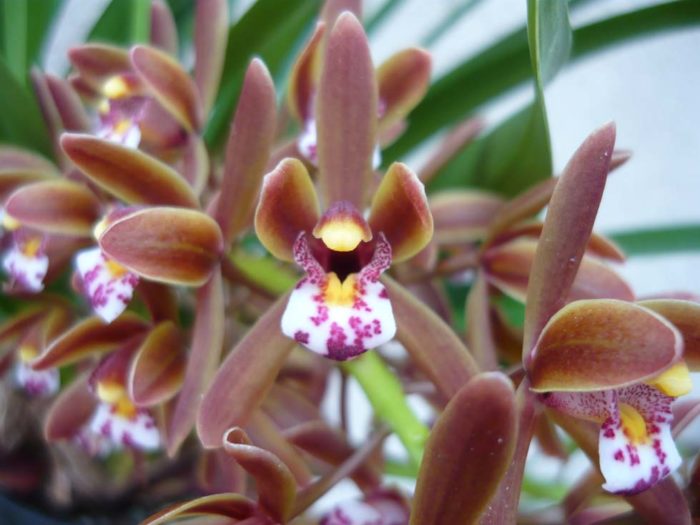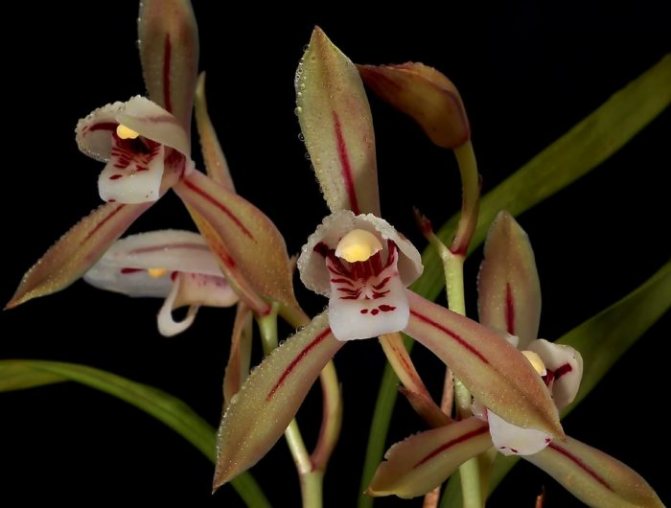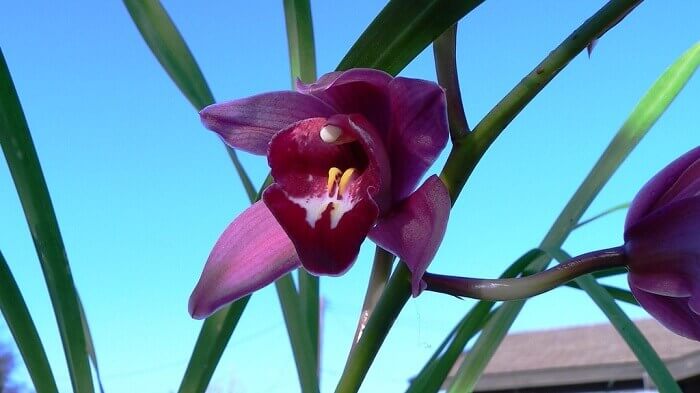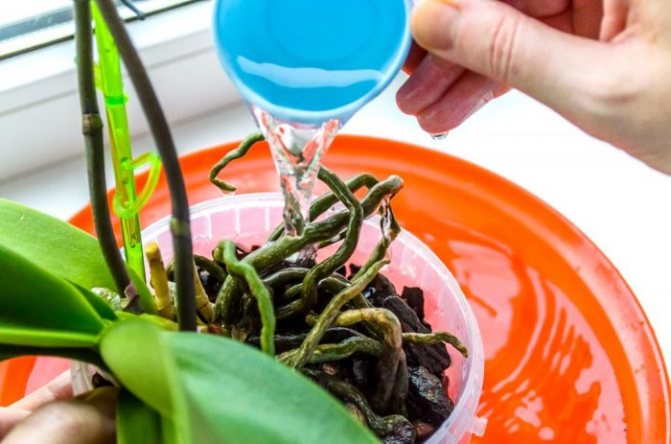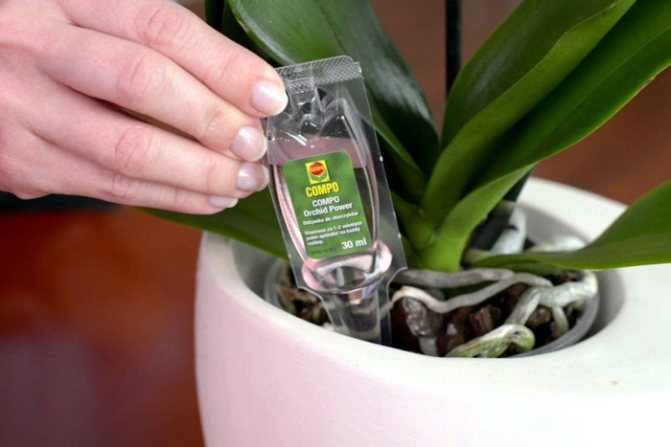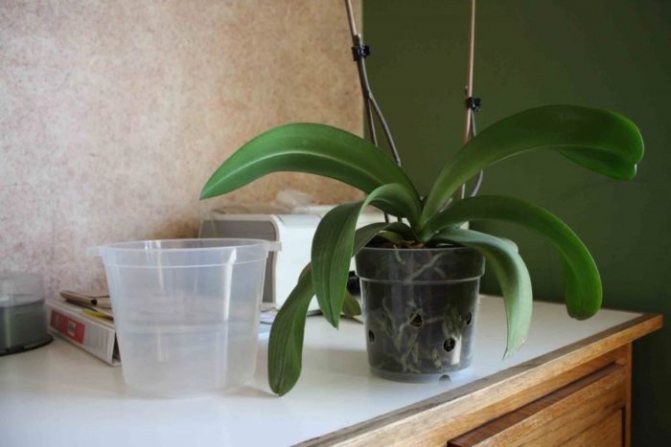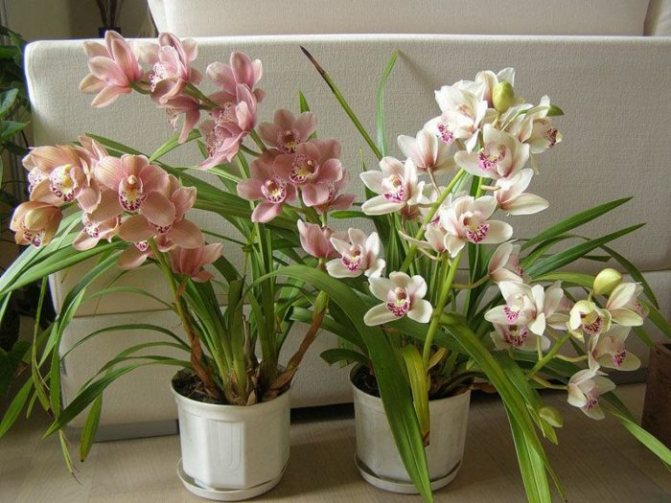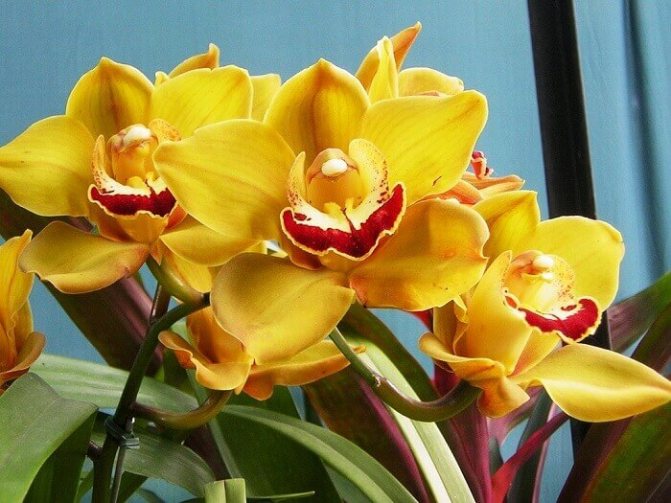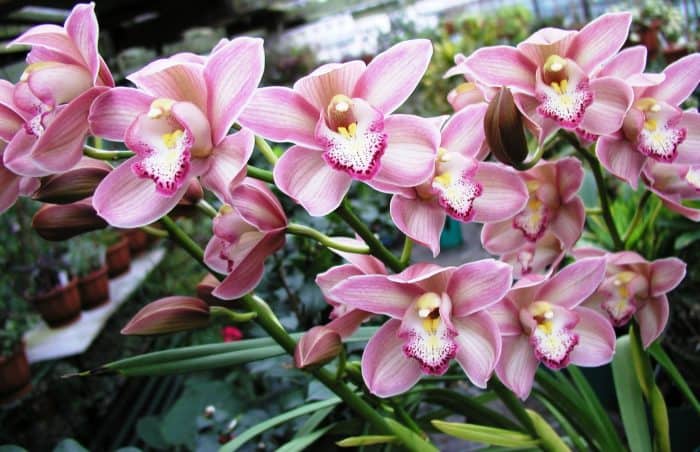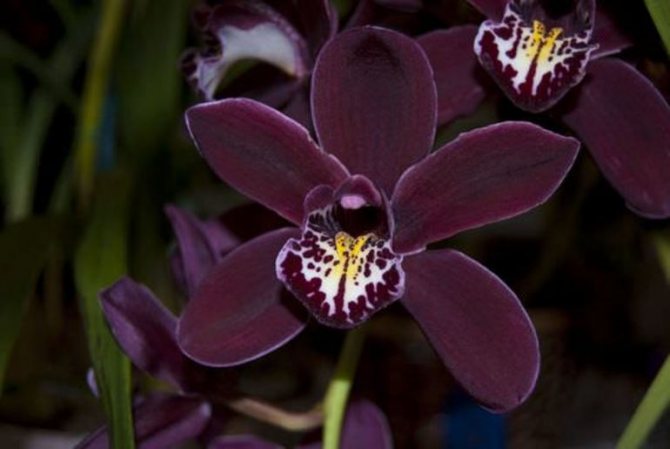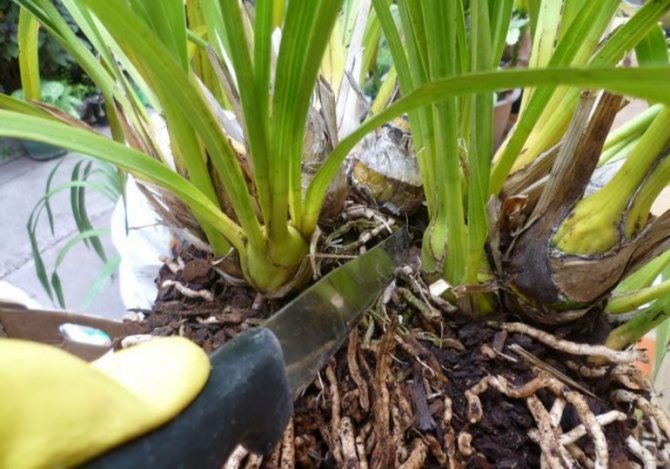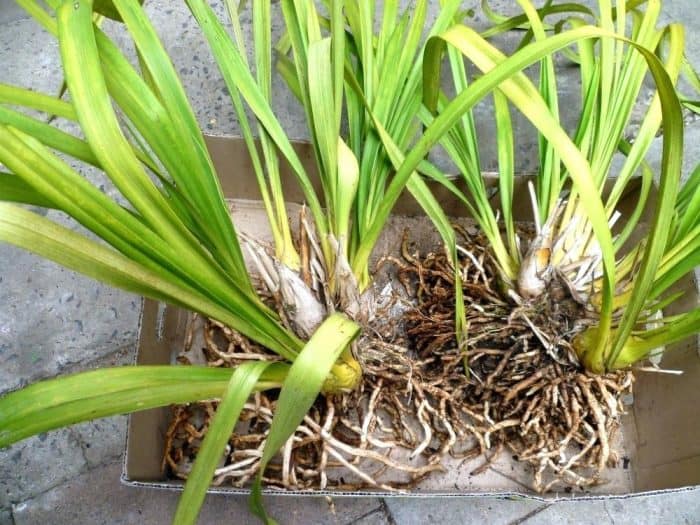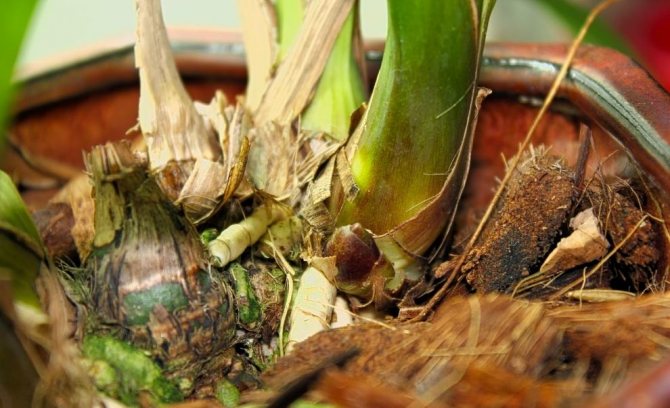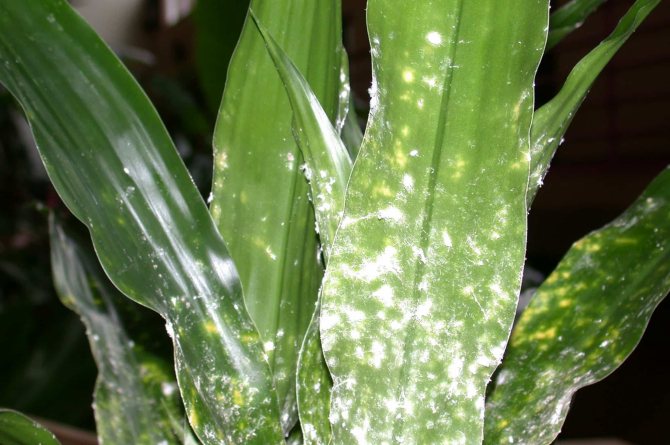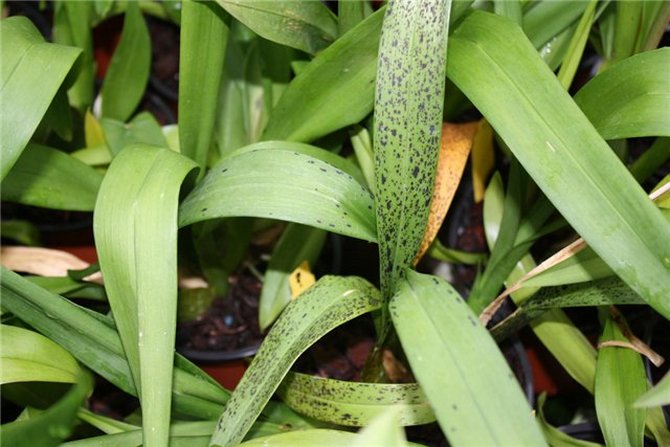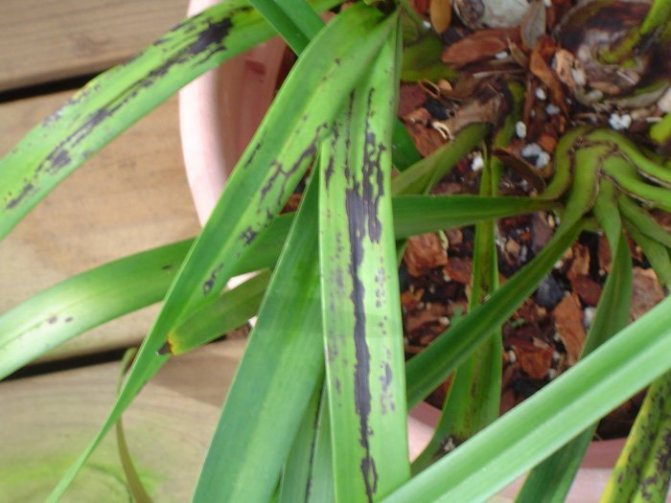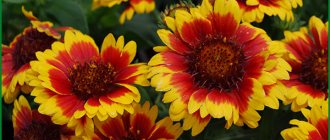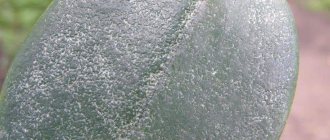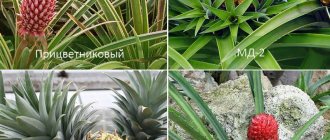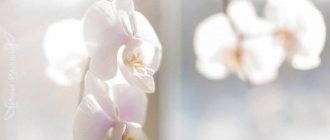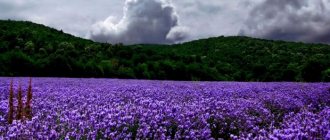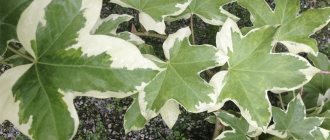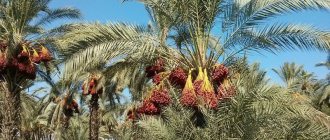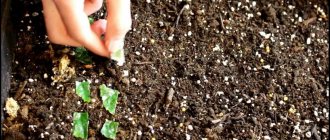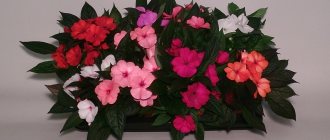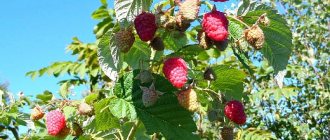Cymbidium - orchid native to the tropics... There are about seventy varieties in nature. Now flower shops sell hybrids of natural forms that bloom in different months.
If you provide proper care and create a favorable indoor climate for growth, you can achieve alternating flowering of different varieties at home. We present to your attention their varieties, photos and names.
Cymbidium orchid: photo and description of the variety
How to distinguish Cymbidium from other orchids:
- the presence of a pseudobulb - part of the stem at the root, where the plant accumulates moisture;
- sepals and petals match in color and shape. They are either rounded or elongated at one end;
- the presence of the so-called "lip" - an outgrowth in the sepal of a variegated color;
- leaves are shortened or elongated, pointed or rounded, dense, hard or fleshy.
Most common colors
The color of the cymbidium petals:
- cream or light milky, lip with small scarlet strokes and a yellow center;
- from bright yellow to pale yellow-green, the color of the lip coincides with the color of the petals, it also happens with bright red blotches;
- brown and burgundy in all shades, a white lip with yellow spots, its color can be richer or paler than the color of the petals.
Distribution in nature
Cymbidium orchid in nature is an epiphytethat is, it grows attached to trees, shrubs and rocks and the ground. Orchid of this species receives nutrients through photosynthesis... It takes moisture from the air and precipitation, and uses the plants as support.
The homeland of Cymbidium is the tropical forests of South and Southeast Asia, Japan and India. Several varieties are from the mountains of Australia and Indochina.
Currently cymbidiums are found naturally in different climatic zones: in the forests of the tropics and subtropics, as well as in the subequatorial climate of the Himalayan mountains.
Reproduction
Cymbidium multiplies in two ways - by dividing the bush and by seeds.
Dividing the bush
This is the easiest way to reproduce. It is combined with a plant transplant so as not to disturb the root system once again.
- Remove the cymbidium from the pot.
- After cleaning, divide the plant into several parts, while leaving on each divided plant several green bulbs and one brown, old one. It is in the old bulbs that the cymbidium orchid retains useful substances, which it then uses in case of unfavorable conditions.
- Remove rotten and dry roots, sprinkle with charcoal and dry.
- Plant the delenki in a suitable substrate. Spray, water sparingly, and keep in a warm place.
- The emerging young leaves will signal a successful rooting.

How to germinate a seed?
You can try to propagate the cymbidium orchid using seeds. Although it will take quite a long time.
- Orchid seeds are placed in pre-prepared soil, consisting of crushed moss and leafy soil. The soil must be moist.
- It is now very important to set a constant temperature between 22-25ºC and high humidity. You can get these conditions in small greenhouses.
- As soon as shoots appear, we dive and continue to grow until 4 leaves appear.
- Then you can safely plant seedlings in pots for permanent residence.
Types and names of Cymbidiums
Eburneum
The petals are large, ivory. The smell of flowers is similar to that of lilacs.
Demanding on moisture and light, the temperature of the content is moderate. Flowering begins in spring.
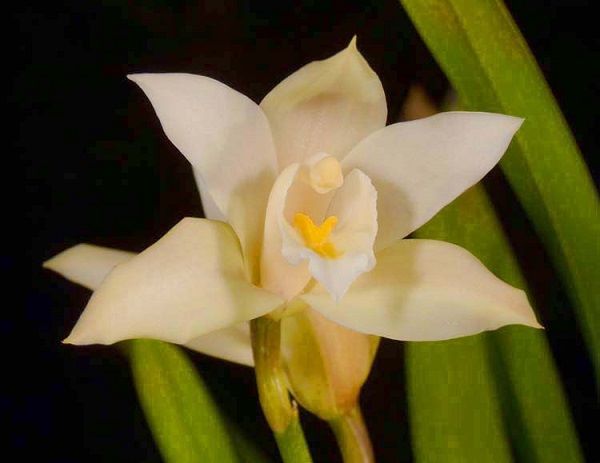

Aloe
Originally from India. Height - up to 40 cm, flower diameter - up to 4 cm; the color of the petals is light yellow and deep red.
The inflorescence is falling, the bulbs are ovoid.
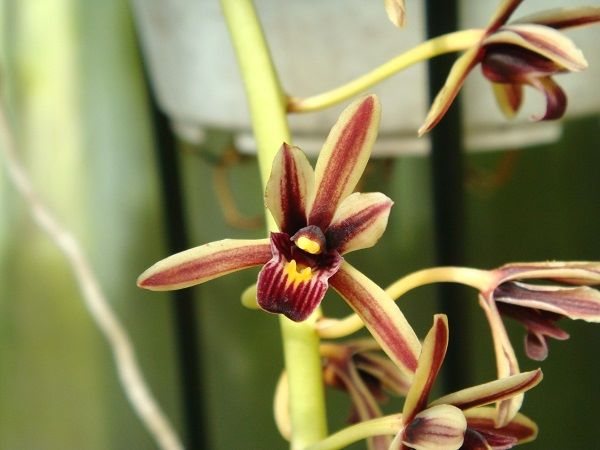

Lanceolate
A green orchid native to Southeast Asia. It has long, wide leathery leaves.
A shoot with buds grows up to 40cm, with flowers up to 5cm in size. The petals are light green, the central vein is scarlet... Blooms for a month, starting in spring.
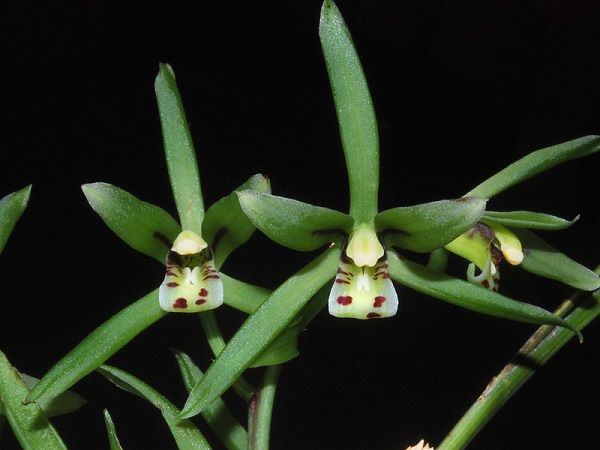

Originally from the Philippines. Flowers up to 5cm in size. The inflorescence is drooping, multi-flowered. Up to fifteen buds on one peduncle.
The color of the petals is cream, the vein in the center has burgundy stripes; lip - white. Blooms in late summer.


Tracey
Elongated leaves up to 60 cm. Flowers - bright yellow with red stripes, size - up to 15 cm; the lip is fringed. Inflorescence - 120 cm; the peduncle is straight or curved in an arc.
It blooms from early autumn to mid-winter.
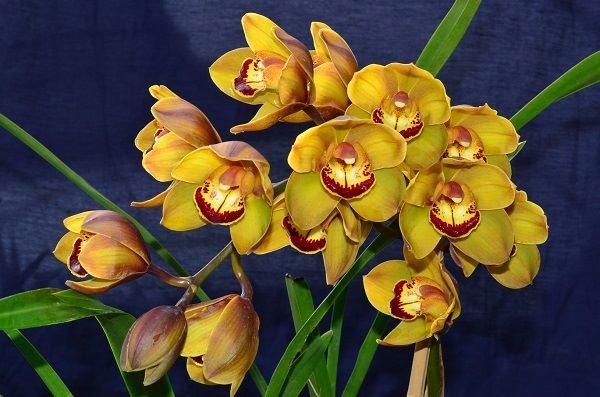

Homeland Burma, India. Almost up to a meter, the leaves are long, thin. Peduncle - strong, curved, can reach one meter. It lays about thirty flowers on one shoot.
Blooms from winter. Bulbs are flattened. The color of the petals is yellow, on the lip there are scarlet blotches.


Dwarf
Homeland China. Bulbs up to 2.5 cm high. Erect inflorescence up to 12-13 cm.
The petals are red with a yellow edge. The lip has reddish brown spots on a white background. Blooms from mid-winter.
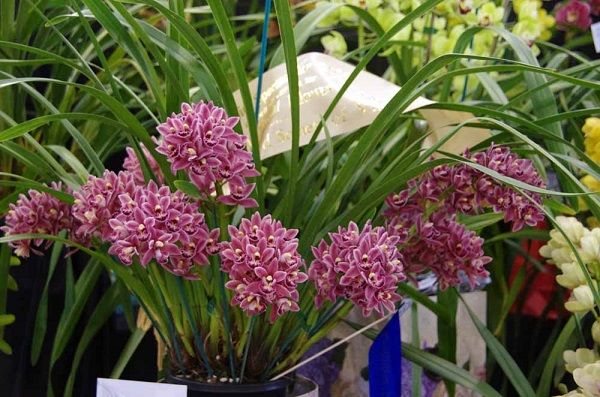

Giant
Homeland Himalayan mountains. Leaves are lanceolate, pointed, up to 60 cm. The flower stalk is strong, lays up to fifteen buds; inflorescence - hanging, up to 60cm.
Petals are yellow-green interspersed with burgundy stripes. Blooms from November to mid-spring.
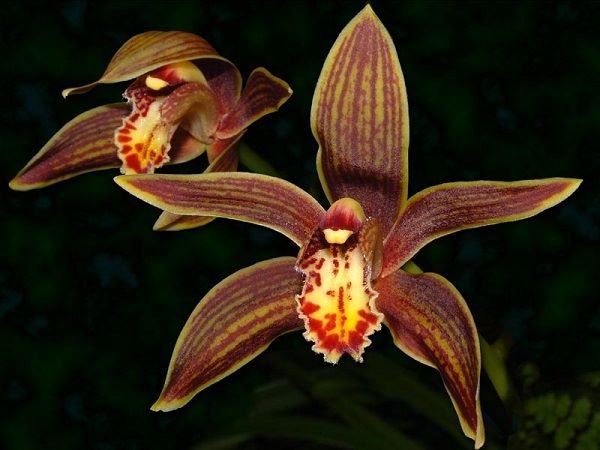

What you need to know when choosing a cymbidium
Going to a flower shop, you must definitely know how to choose a healthy plant, which will only delight you with its beauty in the future. Of course, you need to pay attention to the beauty of flowers. But this is not important. The main thing is to distinguish a healthy specimen from a sick one, and also take into account several aspects:
- An orchid is a child of the tropics, and if the temperature outside is close to 0 ° C or dropped below, this is not the best time to acquire a delicate flower. Even a short stay at such a low temperature can be detrimental to the orchid. Therefore, it is better not to risk it and postpone the purchase to a warmer season.
- It is very common to see freestanding shelves with a variety of colors in large supermarkets. Here they are rarely given proper care. And they get sick much more often than those sold in flower shops, greenhouses and greenhouses. That is why it is better to find special shops or centers in advance and go shopping to where you can get not only a healthy flower, but also a full-fledged consultation of a specialist.
- Consider whether to buy an abundantly flowering plant. Do not forget that it spends a lot of energy on the growth of flower stalks, flowering depletes the orchid. And she still has to move to your apartment, adapt to the new atmosphere, temperature and humidity. All this may not be able to cope with the abundantly flowering orchid and it can get sick, even if you purchased an absolutely healthy plant.
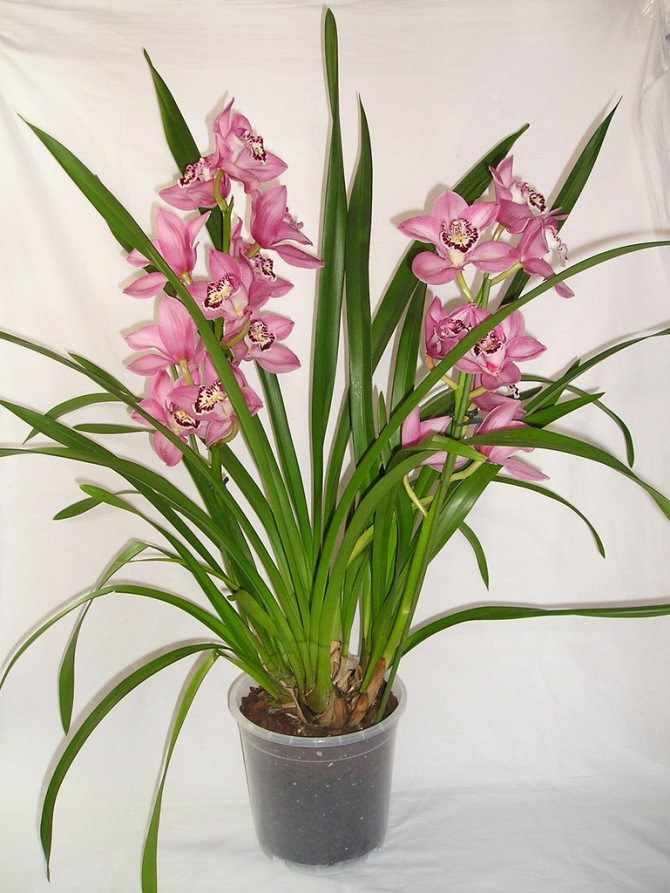

This does not mean at all that it is necessary to buy a young, non-flowering plant. It is best to stop at the golden mean.Either the arrows of the peduncles have just begun to bloom, or there are not many of them. - Before purchasing an orchid, take a close look at how firmly it is planted in the pot. Be very careful at the very base of the stem to move the plant a little. If this happens, then it was recently transplanted and it has not yet had time to catch its roots in the soil. It is undesirable to acquire such a plant. Look at the roots immediately. Since the orchid is planted in transparent pots, this is not difficult to do. They should be firm, not wrinkled or dry out. Have a light green or white color if the flower is sitting in a dry substrate. If it has been recently watered, the color of the roots may be dark green. Neither gray nor brown should be present. Don't worry if orchid roots are hanging from the pot. This is just fine. The main thing is that they are alive. The root system is the most important part that not only supplies the plant with moisture, but also participates in the process of photosynthesis.
- Pay attention to the orchid leaves. If the leaves are dense, elastic, undamaged and have the same shape, this is a good sign. If you notice any spots, scratches, then it is better not to take such plants, since the orchid will need a lot of strength to restore. Look at the growth points. They must not be damaged.
External characteristics
Pseudobulbs
Pseudobulb - part of the stem with a thickeningin which the plant accumulates moisture and nutrients.
Bulbs are located close to each other. Height - from two to ten centimeters... Leaves and peduncles are located at the base of the bulb.
Height of an adult plant
Plant growth depends on the Cymbidium variety:
- giant - up to two meters;
- dwarf - up to 20cm.
Number of leaves
The number of leaves depends on the number of bulbs in a pot. One bulb produces an average of 5–7 leaves. In a small pot, 10-12 bulbs can grow at the same time and, accordingly 70 leaves... The lifespan of a leaf is about three years, then it dies off and a new one grows in its place.
Maximum peduncle length
The size of the peduncle of the plant also depends on the variety. Cymbidium giant and Lowe have can reach 75 cm and contain up to thirty-five buds. Peduncle shape - straight or hanging.
Flower diameter and shape
Size - from 3 to 13cm. The flower has five petals. Depending on the variety, the shape of the flower can be round and elongated. Sepals and petals are monochromatic and interspersed with a different color. The lip is bright, three-lobed.
What does a flower look like from a photo?
There are several features of all cymbidium orchids:
- the leaves are long and narrow, can reach 90 cm in length, and they are about 5 cm wide;
- leaves are green, may have small scales, pointed and blunt ends are possible;
- flowers can be of different shades, while their size is from 3 to 7 cm in diameter;
- up to 15 buds on the peduncle;
- the root system is well developed, but it is more designed for the flower to hold on to the soil, and it does not absorb nutrients very well.
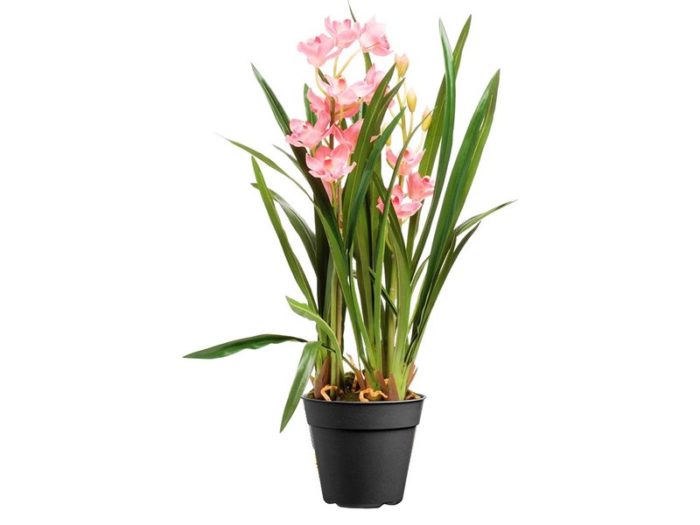

Reference. This culture feels good in the apartment. There are a large number of varieties that are successfully bred by flower growers today.
The main features of flowering
The necessary conditions
Under what conditions does a peduncle appear:
- the difference between day and night air temperature is 5 ° C;
- top dressing with complex fertilizers with potassium and phosphorus, start feeding when new shoots after a dormant period grow up to 10 cm;
- supplementary lighting in the winter. In insufficient light, the peduncle either does not appear at all or it will be weak, with a small number of buds.
Time
For different varieties, the active growth season begins in late winter or early spring., and flower buds are laid in August - October. During this period, the plant needs diffused sunlight.
Peduncles are formed in internodes, and as they grow, they break through the leaf stalks.Reduce watering to once every 1.5 weeks.
Duration
A healthy plant lasts from 1.5 to 3 months... Use potassium-phosphorus fertilizers only before the flower stalk.
A separate article is devoted to caring for the cymbidium on our website. Here we will briefly go over some of the points of departure.
How to care for a plant during flowering:
- stop fertilizing;
- moderate watering, as the soil dries out;
- avoid drafts and sudden temperature changes;
- make a support for the peduncle.
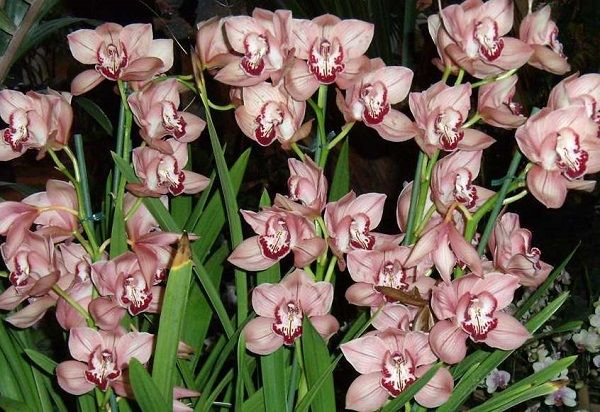

During flowering, the peduncle needs support.
Is it possible to repeat?
An old bulb, on which there was already a peduncle, not capable of re-flowering... The peduncle is formed on new, young pseudobulbs.
Care errors and their elimination
When growing Cymbidium, improper actions on the part of the grower are possible, which often leads to negative consequences for the tropical plant.
It is useful to find out more information about maintenance errors, methods of elimination and prevention of negative effects:
| Problem | The reasons | Elimination |
| Leaves turn yellow and dry | Dryness of air and soil. Rare watering. Excess sunlight. A pest has started - a spider mite. Excess nitrogen fertilizers | Correct errors, normalize the humidity of the environment and substrate |
| Rots | Waterlogging of the soil. The soil does not dry out after the next watering. Excess sphagnum moss in the flowerpot combined with excessive soil moisture. Poor drainage. The fungus is brought in with poor-quality soil | Moisten the substrate moderately. Normalize the outflow of water from the flowerpot. Disinfect the finished orchid substrate with potassium permanganate or fungicides |
| Does not grow | Poor quality substrate. Weak vegetation against the background of an incorrect temperature regime. Rare dressing, unsuitable fertilizers. Lack of lighting | Eliminate factors that interfere with the active growth of a tropical flower |
| Does not bloom | Non-observance of the temperature regime during the ripening of peduncles and the formation of buds: it is too hot in the room | During the laying of the elements involved in flowering, maintain the indicators in the room at a level not higher than +15 degrees |
| Spots on the leaves | When spraying, a florist uses a spray bottle with large holes. Water stains reduce the aesthetics of the flower | Water and spray the Cymbidium orchid correctly, avoid large drops on the green mass and buds |
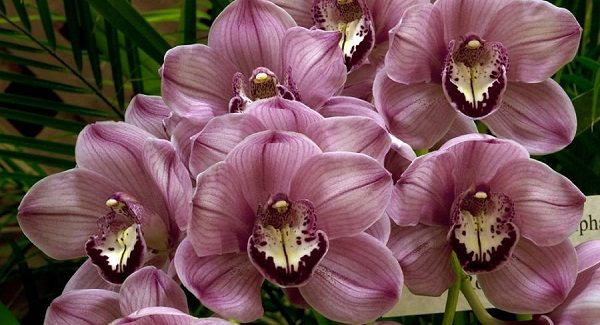

Growing conditions
Temperature regime
Optimum temperature in summer - up to +28 ° C; in autumn in spring - up to +18 ° C... At very high temperatures and dry air, plant growth stops; at low - dropping flowers, damage to leaves by diseases.
During the maintenance of the flower, make differences between the air temperature during the day and at night; the difference in thermometer readings must be at least 5 ° C.
During flowering and during the dormant period, which occurs immediately after the last petals are shed, temperature fluctuations during the day are not necessary.
Plant location
- during active growth - sill of the southern or southeastern window, with obligatory shading during the daytime sundial;
- during flowering- remove from the bright windowsill;
- during dormancy - move the plant pot to a darker place.
Humidity
Cymbidium Orchid, as a representative of the tropics and subtropics, demanding on high humidity in the room... The humidity rate is up to 60%.
How to achieve this indicator:
- use humidifiers, indoor fountains;
- spray the leaves and air around the plant twice a day;
- put an open container of water next to the flower.
Priming
The soil must be porous, hygroscopic... The option for preparing the soil is to take in equal quantities:
- sphagnum moss;
- humus or peat;
- pine bark;
- coconut flakes.
Capacity
- pot plastic or clay;
- there is no need to use only a transparent pot, as for phalaenopsis;
- the depth should be such as to place the drainage layer on the bottom. Wherein the bulbs should be at ground level.
Lighting
- cymbidium orchid grows well and blooms in the diffused rays of the sun... The sun's rays in the daytime in summer can burn the leaves;
- in the summer months, place the orchid on the east or north window, in the cold months - on the south or southeast;
- on winter days, supplement the plant with a phytolampto extend daylight hours to 12 hours.
Air humidity
Cymbidiums are patient with low air humidity, but only at a comfortable temperature of 18-24 ° C. With a hotter content, the humidity around the orchid should rise to 55%. In this case, Cymbidiums can tolerate up to + 45 °.
At high humidity up to 70%, the orchid will develop faster.
It is most convenient to keep this type of orchid on the balcony or outdoors in the spring and summer. The natural temperature drop and humidity will provide Cymbidium with the required conditions.
The origin and appearance of the cymbidium orchid
Back in 1800, a Swedish botanist discovered a new species of orchid - cymbidium. In nature, this surprisingly unpretentious plant can be found in Thailand, Burma, Australia. I can't even believe that such a wonderful flower grows on rocks, sand and just on trees. There are more than fifty varieties of orchids, some grow in the tropics, and there are those that are not afraid of the harsh climate of the Himalayan mountains.
Cymbidium is a genus of evergreen epiphytic plants of the Orchid family. The appearance is familiar to everyone now, you will not confuse this flower with any other. The color range of petals can be very diverse - from pure white to various shades of lilac. Pseudobulbs are located tightly to each other, on their base are flower stalks. The number of buds varies from 1 to 5–7. There are specimens with more than 10 flowers on the peduncles. Their diameter reaches 12-13 cm.
Is it difficult to keep at home?
Keeping a cymbidium orchid at home cannot be called easy, the plant needs certain conditions. A beautiful flower requires increased attention and adherence to the rules of care.
There are a great many varieties of cymbidium orchids, but the maintenance and care of them is the same. What types are most common among amateur flower growers and are well studied by specialists?
- Cymbidium is wonderful. An orchid that grows in China, Thailand, Vietnam. The oblong, elongated leaves are deep green, the flowers are not very large, the maximum size rarely exceeds 8 cm.The color of the petals is light pink, with small scarlet spots. The flowering period lasts from February to May.
- Giant cymbidium. Found in India. It got its name because of the rather long leaves, the size of which exceeds half a meter, and the large inflorescence, bearing from 10 to 15 flowers. The color of the petals is greenish-yellow, with purple-red stripes. Blooms from November to April. Does not require special care, very unpretentious.
- Cymbidium Tracy. This type of orchid is common in Burma. The leaves of the plant reach 60 cm, and the flowers are very large, about 15 cm in diameter. The color of the petals is light yellow with small red spots. Blooms from September to January. Requires high humidity and frequent spraying.
- Cymbidium miniature... This name speaks for itself. A small orchid that can win the heart of a grower. Gracefully hanging bunches of small (about 2 cm) flowers give the impression of lightness and transparency. A rare orchid lover will be able to pass by this splendor. It also grows at a wide range of temperatures: from moderately cold to warm. It begins to bloom in August.
- Lanceolate cymbidium. It grows in Asia. This species has small flowers of light green color with a red stripe in the center, reaching a diameter of 5 cm.This orchid has wide and long leaves, glossy, rich green.
Diseases
Cymbidium is a robust orchid species and is rarely affected by disease. The main problems that can be encountered when growing it are as follows.
1. Dot yellowing of leaves - damaged areas have a rounded shape, appear immediately and do not spread. The phenomenon is observed with sunburn of the leaves, and usually in summer. To eliminate the problem, the flower must be shaded urgently.
2. Decay of pseudobulbs is a characteristic pattern when irrigation is improper or moisture gets into the base of the leaf.
The rot is cut out, and the wound is covered with activated carbon. After that, the plant is not watered for a week.
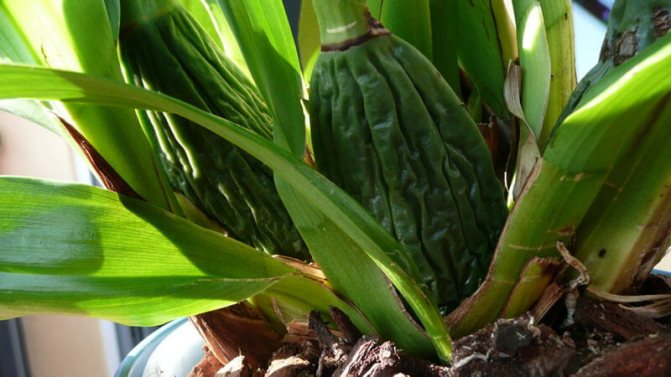

3. Yellowing of whole leaves - the phenomenon can be a natural process or a signal of a lack of moisture and nutrients.
The soil is checked for moisture level and, if necessary, the flower is placed in water. Top dressing is carried out every 2 weeks only with compositions for orchids.
4. Curling of leaves - occurs when the flower is suddenly moved to the cold. You should not buy cymbidium when it is freezing outside.
Problems that arise with an orchid are usually associated with improper care of it. If detected early, they are removable. When detected late, rot affects too much of the plant, and it is almost impossible to cure the flower.
Strictly observing the recommendations on how to care for the cymbidium, it will be possible to avoid diseases.
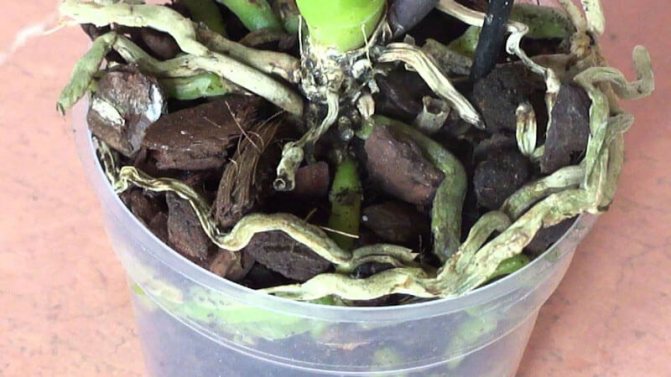

Orchid species popular with flower growers
The genus cymbidium has many representatives. Fans of floriculture know not everything. There are also breeding hybrids. Most often at home you can find:
- Cymbidium eburnum (ivory). Differs in large flowers (12 cm in diameter) of an exquisite cream shade with a slight pearlescent sheen. It is appreciated for its unmatched scent, reminiscent of the scent of lilacs.
- Aloe leaf cymbidium. Plant height - no more than 30 cm. Flowers are pale yellow with a burgundy lip. Diameter - 4.5 cm.
- Cymbidium is lanceolate. A flower of unusual color, sepals and petals are colored light green with thin dark scarlet veins. The lip is snow-white with a pattern of spots and stripes of brick color.
- Cymbidium Tracy. The height of the peduncle is about 1.2 m. The flowers are large (15 cm in diameter), yellow-green in color with red-brown strokes. The lip has a wavy and sometimes fringed edge, creamy, covered with small scarlet spots.
- Cymbidium Day. The inflorescence of the orchid is very impressive, with numerous flowers, the diameter of which is 5 cm. The petals and sepals are painted in noble shades of ivory. The lip is snow-white, its anterior lobe is twisted.
- Cymbidium Low. Very large flowers (20 cm in diameter), the petals of which have a greenish-yellow tint, and the lip is colored dark crimson with a yellow border. The plant reaches a height of 1 m.
- Sword cymbidium. Litofit. The flowers are incredibly fragrant, up to 5 cm in diameter. Sepals and petals are light yellow with burgundy veins. The lip is greenish, with a dark red speck in the middle and brown stripes on the sides.
- Cymbidium is yellowish white. Found naturally in the Himalayas. The orchid is large. The diameter of the fragrant flowers is 7.5 cm. The buds are cream colored, and the lip is yellowish with red dots.
- Cymbidium is dwarf. A very rare plant native to Japan. Differs in petals of a red-brown shade with a yellow border around the edges. The lip is white with dark red spots, the shape of the middle lobe is curved.
- The cymbidium is giant. A plant with very large flowers (15 cm in diameter), exuding a strong aroma. The petals are yellow-green and covered with red strokes, the cream-colored lip is decorated with spots and stripes. Some breeding hybrids are dominated by red shades. The length of the inflorescence is about 60 cm.
- Cymbidium is wonderful. The species is distinguished by a large, beautifully flowing inflorescence up to 80 cm long. The diameter of the flowers is 7–8 cm, they are painted in pale pink and are mottled with red spots.
Content
- Listen to the article
- Growing features
- Cymbidium care at home How to care
- Watering and feeding the cymbidium
- Cymbidium transplant
- How to make bloom
- Cymbidium does not bloom
- Cymbidium eburneum
How to choose the right plant?
Modern breeders have developed a huge number of hybrid forms adapted to growing "in captivity". Most often in flower shops there are just such, and not "natural" plants. When choosing, you need to pay special attention to the condition of the roots, leaves, peduncle and the age of the orchid.
Ideally, if the cymbidium has a well-developed root system. It is not difficult to assess its condition, since orchids are usually sold in transparent plastic containers. A healthy plant has fleshy olive-colored roots. Well, if their tips are bright green, this means that the orchid is in a phase of active growth. Examine and touch the aerial roots. They must be resilient. Softness and "hollowness" means that the plant at home will have to be reanimated, and this time-consuming procedure does not guarantee a positive result.
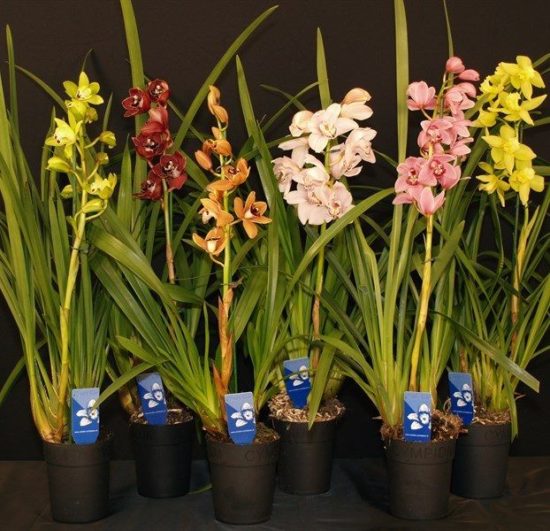

Most often in flower shops there are selective cymbidium hybrids.
A healthy orchid has dense and elastic leaf blades of a light green tone with a reddish edging along the edge. There should be no plaque, specks or dots. Do not buy an orchid with wrinkled and sluggish leaves. A dark green color indicates that the cymbidium lacked light, and a reddish or yellowish tint indicates an excess of it. It is best to refrain from buying a plant with such problems.
An important factor to consider when choosing a cymbidium is the age of the orchid. The mature plant is large, it is able to bloom profusely and produce offspring.
Most often, when choosing an orchid, first of all, they pay attention to its flowering. Estimate the number of blossoming flowers and buds, the more, the better. Once in the apartment, the orchid suffers severe stress, it needs time to adapt to new conditions. Therefore, she can shed open flowers. This is normal.
Be sure to inspect the growth point. It should be firm and firm to the touch. Any stains and mucus are a reason to refuse a purchase.
Diseases and pests, control methods
Main problems:
- fungal infections, decay. Against the background of excessive watering and stagnant liquid, mold appears. Fighting: removal of affected elements, treatment with fungicides, normalization of the soil moisture regime, correction of spraying taking into account the room temperature. When planting and transplanting an orchid, it is important to equip a drainage layer;
- spider mite attack. The main factor is dry air. With a moisture deficit, parasites multiply rapidly, suck out juices, and damage leaves and buds. Control methods: warm shower, removal of pests from the plant, treatment with soapy water followed by the use of acaricides. It is important to normalize watering. If the air is too dry, a moistened "natural sponge" - sphagnum moss is laid out in the pallet;
- the use of acaricides and fungicides is carried out in gloves, a respirator, and a headdress.Clothes must necessarily cover the hands. Plastic goggles are used to protect the eyes. Violation of the rules for processing plants with the use of chemicals often leads to intoxication of the body.
Conditions required for a flower, depending on the season
Compared to other orchids, cymbidium is considered unpretentious, but this does not mean that you can forget about the acquired plant. Regular flowering is possible only under conditions that are close to optimal. Therefore, it is worth listening to the "wishes" of the flower, because the microclimate of its homeland is not at all similar to that which is created in modern apartments.
Table: how to create an optimal microclimate for the cymbidium
| Season | Lighting | Humidity | Content temperature |
| Spring Summer | The orchid is very light-requiring, but the plant can get burned from direct sunlight. The ideal option would be to be located on a window in a south or east orientation, but it is better to shade the plant with tulle from the scorching sun. | Humidity should be at least 50-60%. On hot days, you should spray the cymbidium as often as possible, and also install a humidifier, a decorative fountain or a tray with wet pebbles next to the plant, from which water will evaporate. | 25-30 ° C during the day and 14-15 ° C at night. It should be borne in mind that such a temperature difference is a necessary condition for flowering. |
| Autumn winter | The orchid needs to be supplemented with fluorescent lamps or special phytolamps. Cymbidium should be exposed to light for up to 12 hours a day. | The number of sprays should be reduced to once a week if the air in the room is too dry. Please note that when kept cool, they must be abandoned altogether, since the orchid can rot. | Cool hibernation with temperatures of 14–16 ° C during the day and 10–12 ° C at night. |
Cymbidium care at home
How to care for cymbidium
Growing cymbidium requires special knowledge from the grower. It is best to keep the cymbidium on the windowsill of a large window, in the bright sun, shading it at noon from direct rays, especially during flowering, with a light curtain. In general, this orchid requires a lot of light. Cymbidium blooms usually occur in the winter months, when the daylight hours are short, so additional lighting will have to be organized for the orchid.
As for the air temperature, the cymbidiums tolerate cool air more easily than heat and stuffiness. This is especially important in winter - being near heating devices will not give the cymbidium the opportunity to amaze you with its flowering.
Your orchid will need high air humidity, in the range of 50-60%, so in the summer you will have to spray it at least three times a day. It helps to solve the problem of air humidity by placing a pot with a plant on a pallet with wet pebbles or expanded clay.
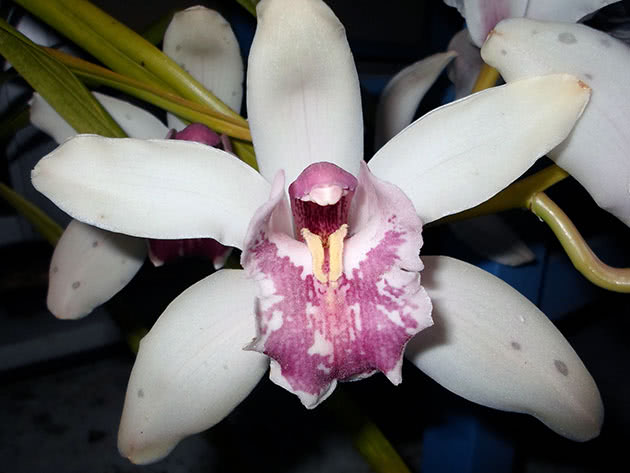

Watering and feeding the cymbidium
During the period of active growth, it is necessary to water the cymbidium abundantly, but it is important that the water after watering does not stagnate in the roots, otherwise the roots of the cymbidium may rot, and black spots will appear on the leaves. If there is not enough moisture for the plant, pseudobulbs may shrink, and flowers and buds may fall off. Closer to winter, watering is reduced and the substrate is moistened only once every two weeks, if the temperature of the content is normal, but if the room is too warm, then you will have to water more often.
Top dressing of the cymbidium is combined with every third irrigation, and is applied in the form of solutions to an already moistened substrate. It is best to use for this special fertilizers for orchids (Kemira Lux, Ideal, Rainbow) in half the concentration of that indicated on the package. In the middle of summer, the nitrogen component should be reduced, and the potassium component should be increased. During the flowering period, the orchid does not need feeding.
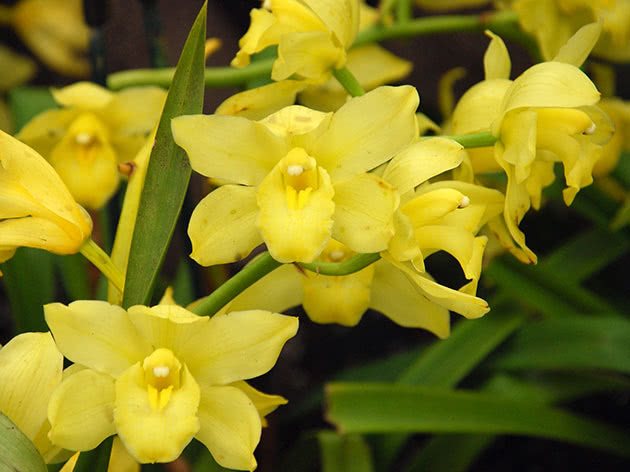

Cymbidium transplant
Caring for the cymbidium also involves transplanting the plant into a larger pot as the roots fill the old one. There is such a need every two to three years. This is done after the orchid has already faded, and the young growth has grown to at least 5 cm in height. How to transplant cymbidium?
First, we will choose a substrate for the cymbidium. The soil for the cymbidium is purchased special, for orchids, or compiled independently. To do this, you need to take pine bark as a basis and add finely chopped sphagnum moss and fern roots, a little rotted horse humus and charcoal to it. Mix all the ingredients, pour a 2-3 cm layer of substrate into the pot, in which there should already be a drainage layer of expanded clay or clay shards, and transfer the cymbidium with an earthen lump to the pot, then add so much substrate so that the pseudobulbs of the cymbidium are above the ground level.
If the roots of the orchid were not damaged during transplanting, water the plant along the edge of the pot, but if you had to clean the root system of rotten areas, it is better to postpone watering for a couple of days. The cymbidium in a new pot is placed in partial shade, where it will recover from the stress of the transplant for some time.
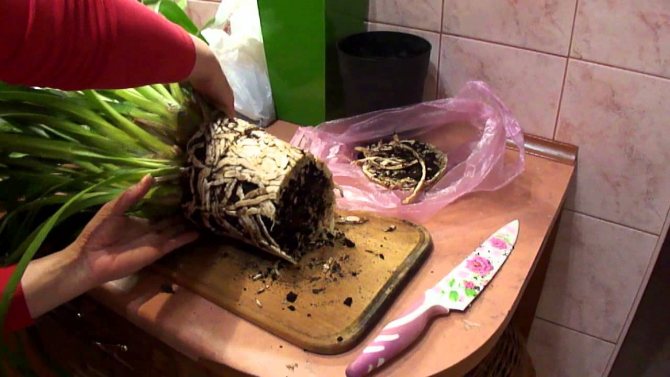

How to make cymbidium bloom
Different varieties and types of cymbidium bloom at different times, and the duration of flowering is also different for them. But any of the specimens of this genus will bloom poorly or will not bud at all at temperatures above 22 ºC. Since cymbidiums of mountainous regions were mainly used to create modern hybrids, it can be assumed that they will need conditions for flowering approximately the same as in their habitats, namely: bright light and a difference between day and night temperatures of 4-5 degrees.
Those orchids that bloom in spring and summer will not have to specially arrange temperature "swings" - at this time of the year such temperature drops are quite natural in nature, and if your orchid is in the garden or on the balcony, it will calmly withstand the night temperature up to 5 ºC, but it will bloom profusely and in time.
But in winter, when the heating system operates around the clock in the room where the cymbidium grows, you will have to invent something ... You can, for example, put the cymbidium on the balcony or loggia at night, if they are insulated. The most abundant flowering with the largest flowers occurs in cymbidium orchids in the third year of growth.
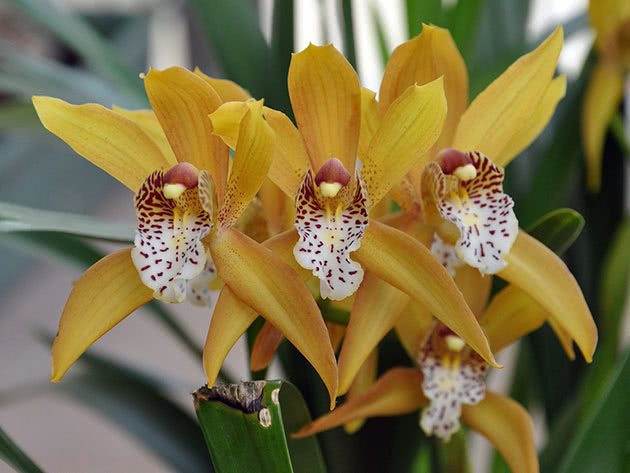

The specifics of cymbidium transplant
The main thing in the process of preparing for an orchid transplant is to choose the right soil. What these flowers require bears little resemblance to soil in the usual sense of the word.
How to choose soil and pot?
The cymbidium orchid is an epiphytic plant, that is, in nature it lives on trees or in hollows, and it sucks nutrients and moisture from the air with the help of aerial roots. The correct substrate and pot will keep the flower upright and keep a minimum of moisture at the roots.
The cymbidium soil contains no earth. It is made up of pieces of bark, charcoal, sphagnum moss. Novice orchid lovers are advised to purchase a special substrate in the store. All the necessary components are mixed there in the right proportion.
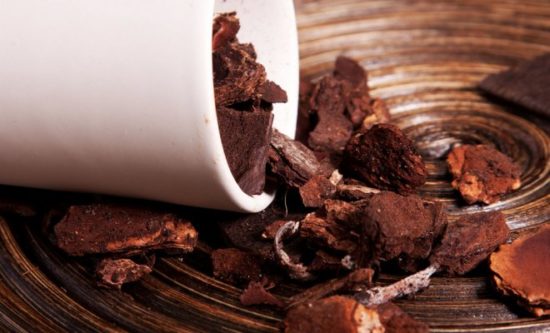

The substrate is made up of pieces of bark, charcoal, sphagnum moss
Since in nature the cymbidium grows mainly in the hollows of trees and in crevices of rocks, its roots do not need light. This makes the flower different from other orchids, for which transparent plastic flowerpots are usually recommended for cultivation at home. For cymbidium, it is better to use frosted plastic containers with many drainage holes. This improves soil aeration and prevents water stagnation.
Transplant: step by step instructions
Frequent transplantation of a healthy cymbidium is not needed. It should only be done when necessary. The flower has clearly outgrown the pot if roots are sticking out of the drainage holes.Another emergency - the plant is damaged by rot and needs to be urgently reanimated.
- Remove the cymbidium carefully from the old pot, being careful not to injure the roots. They are usually rolled into a tight ball. To unravel it, soak the flower in warm water. Immerse the cymbidium in the container for about an hour.
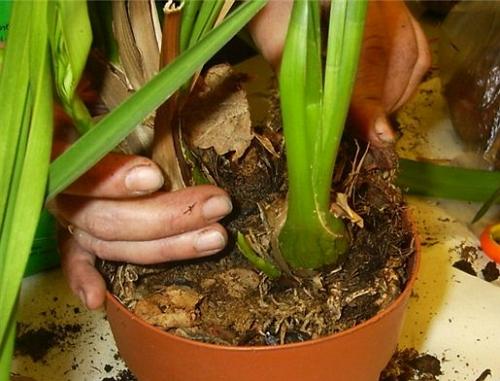

Remove the cymbidium from the old pot, being careful not to injure the roots.
«>
Testimonials
Catherine. “I decided to conduct an experiment and propagate my Cymbidium with pseudobulbs. I separated the bulbs from the bush, left a few with leaves and a couple without leaves. So, those bulbs that were with leaves dried up. It looks like they won't be of any use. And the bulbs without leaves are whole and fleshy. Two months later, new shoots appeared. I will continue to look after and wait for the buds. "
Olga. “I already had a small collection of phalaenopsis when I bought the first cymbidium flower. On the advice of a friend, when transplanting a flower, I added peat to the soil. Since I water my orchids by immersion in a bowl of water, all the peat from the cymbidium pot has come out. My advice to you is not to add it to the soil if you intend to soak your orchids in the same way. "
Oksana. “My wedding bouquet consisted of sprigs of blooming cymbidium. The composition was made with a florist, and I was surprised how delicate flowers would survive such a busy day. And in general, for the first time then I saw bouquets with the Cymbidium orchid. So, two weeks have passed, the bunch is safe and sound. The flowers are incredibly beautiful, I never tire of admiring them; the smell of flowers is unobtrusive, pleasant.
I became interested in this flower, collected information about it and decided to buy a cymbidium in a pot. On weekends I go to the garden hypermarket. "
Location
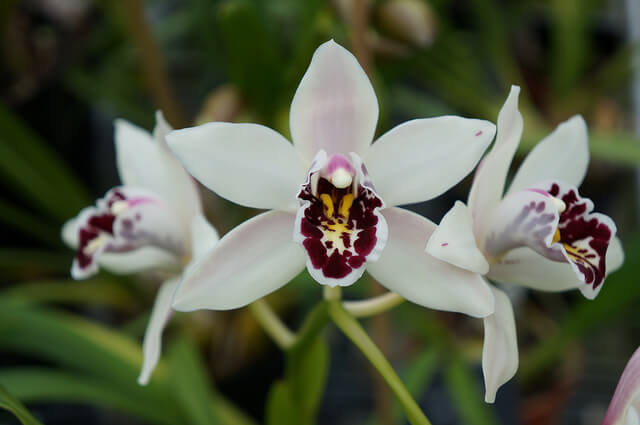

In the fall, the orchid should be on a slightly heated veranda (loggia) - the optimum temperature is less than 16 ° C, keep it until the first flowers bloom. For flowering, the cymbidium needs coolness. Outdoors, the orchid should be from mid-May until the first frost. It must be located on a well-lit area in the morning and evening hours. And in the afternoon - in a light shade. Attention! Do not place the pot directly on the ground, as snails and slugs can eat the plant. Protect the area around the pot with pellets (or cloth) against slugs.
Watch out for heavy rain in the fall. Place your orchid in a shelter: under a roof or under a porch canopy, for example.
Landing
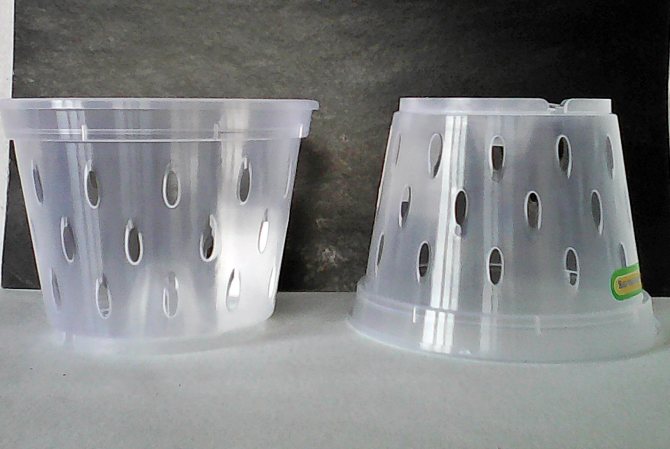

After purchasing cymbidium at a flower shop, it must be transplanted into a suitable container. Transparent pots with drainage holes are suitable for orchids. The container should be small and cramped, since it is necessary that the root system does not reach 2 cm to the walls, and 5 cm to the bottom.
Cymbidium can also be planted in a clay pot, but when transplanting it will have to be broken so as not to damage the roots.
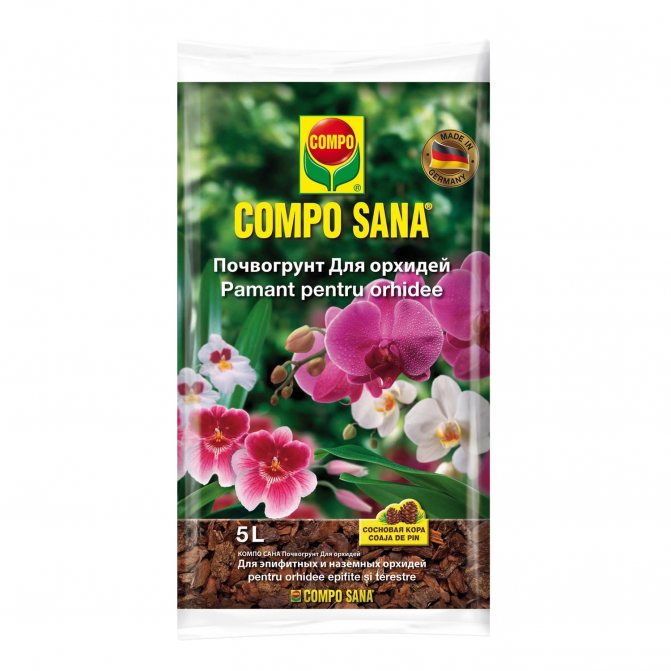

Ready-made primer can be bought at a specialized store. This plant is suitable as a substrate for terrestrial orchids. At home, the soil mixture is prepared from the following components:
- 3 parts of the bark of coniferous trees;
- 2 parts sphagnum moss;
- 1 part each of sand, charcoal, perlite and fertilizer from the leaves.
If the temperature in the room where the pot with cymbidium stands is higher than required, then more sphagnum should be added to the soil mixture. At the bottom of the container, it is also necessary to lay out a drainage layer, which can be used as expanded clay or granite stones.
Which soil to choose
If there is no soil in the store, then it is prepared independently from:
- pine bark;
- sphagnum moss;
- sand;
- perlite;
- charcoal.
Caution! If the mixture is selected independently, then when collecting the bark, you need to carefully examine it for the presence of bugs and signs of illness, after which it is completely doused with boiling water several times. The same procedure should be repeated for other soil components.
When is it time to replant
If the earth ceases to shine through the transparent pot, and only the roots remain in the field of view, it is time to transplant the orchid.
Additionally, you can take a simple pencil and try to stick it into the soil, if this fails, then a cymbidium transplant is definitely necessary.
This video details how to transplant an orchid after flowering:
General information about the flower
Cymbidium, like most orchids, is an epiphyte. Its habitat is the crowns and trunks of trees in tropical forests. In rare cases, you can find representatives of the cymbidium that grow on the ground, on rocky soil. The type of growth is sympoidal - the development of the plant does not occur due to the trunk, which the cymbidium simply does not have, but due to the formation of new rosettes of leaves, from which a peduncle appears in the future. Over time, pseudobulbs appear in the center, which are essentially the growth points of the orchid. The peduncle can be either straight or curved, directed downward - spectacular flowers are located on the peduncle itself. Cymbidium blooms for several months. Cut stalks will delight you with their beauty for a long time.
How to care during the rest period?
Some orchids do not need a dormant period. But for the cymbidium, this period is a physiologically necessary state. In nature, this time falls on unfavorable weather conditions. The ability to freeze for a while helps the plant to tolerate cold temperatures, drought or scorching heat more easily.
Typically, the cymbidium goes to rest in late October or early November. At this time, there is a noticeable change in the content of the plant. The frequency of watering decreases to a minimum - once every 14–15 days, the air temperature drops to 10–12ºC. Such changes in the life of the orchid help to form flower buds and give abundant flowering in the next season.
Detailed botanical description
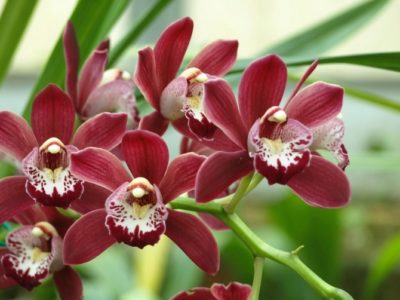

Leaves are medium in size, can reach 25-28 centimeters in length. Sometimes they take the form of an oval with a sharp end, and there are species with blunt ends. The color of the leaf plates is rich, green. They are not very hard to the touch, fleshy.
The peduncle is long compared to other species... Sometimes it grows up to 150 centimeters in length. On this flower arrow, inflorescences are formed, which can hang down under the weight of the petals, thus creating whole brushes.
The size of the opened buds depends entirely on the growing conditions. They reach a maximum of 11 centimeters in diameter. The shade of the petals can be the most diverse, able to please even the most demanding and spoiled grower. Colors are found just cream, and even light green.
The highlight of Cymbidium is its lip - it is large, convex and most often has a bright shade, thanks to which the whole flower stands out against the background of the plant itself, as well as flowers of other species.
Sword cymbidium (Cymbidium ensifolium) ↑
- Terrestrial orchid, inhabitant of rocky terrain.
- The petals are green or yellowish, with reddish-purple veins. The central stripe of the petal is more pronounced, and small purple specks flaunt at its base. The lip is green or pale yellow. The middle lobe of the lip has purple-red spots, the side lobes are decorated with parallel red-chestnut stripes. This can be seen very clearly in the photo below.
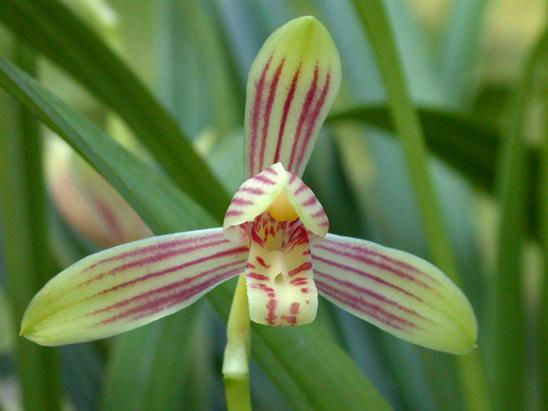

- An inflorescence of 3-9 flowers is located on an erect peduncle 15-65 cm long.
- Flowers 3-5 cm in diameter, they exude a strong pleasant aroma.
- The flowering period is in the months of January-April.
- In the conditions of the greenhouse, Sword-leaved Cymbidium can be seen blooming at any time of the year.
- Hybrids of Cymbidium ensifolium and Cymbidium lancifolium are grown in culture. These are the varieties "Golden Elf", "Peter Pan", "Lovely Melody".
The appearance of peduncles
To achieve the appearance of pseudobulbs, that is, peduncles, it is necessary to observe the watering regime and provide the plant with a normal temperature. Flowering time is the height of spring. The flower does not like the intense summer heat of Russian latitudes. That is why all transplants are done in March - February.
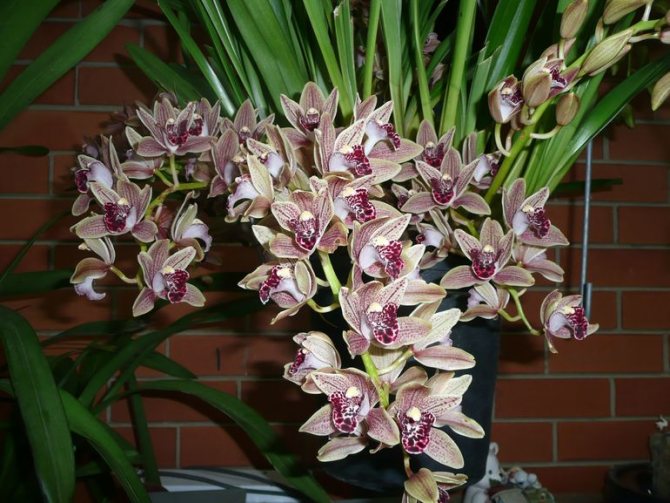

In the cold period of the year (October - March), the appropriate temperature for keeping cymbidiums is up to 20̊C during the day, and at night - 10 - 12̊C. But as soon as the first buds outside the window begin to bloom, you can already start a cymbidium transplant.
It will be difficult to see the flowering of cymbidium in the apartment. You can force the orchid to release the bulb when the growing conditions are ideal for it.
It is necessary to shade the windows and maintain a strictly defined temperature in the room during the day and suitable at night. The main condition for blooming buds is temperature drops. However, small flower varieties are more accustomed to mid-latitude climates. A daily temperature drop of 5-8 5С is enough for them. .
It is these varieties that are best kept in an apartment. Large and large-leaved varieties such as cimbidium grootblomig joel need a daily drop of 10 to 15 ° C. You should not be afraid of freezing a flower. Cymbidiums are accustomed to mountainous terrain and can withstand very low temperatures - around 3-5 ° C at night.
What to do with a peduncle after flowering?
The orchid has faded, and the flower stalk is still green. How to be? Wait to see if it starts to dry on its own. And if this happens, let the plant get all the nutrients from the peduncle and only then cut it off.
Has the peduncle stalk completely turned yellow? You can start removing it. The cut must be done so that a small stump remains at the base, about 1–1.5 cm.
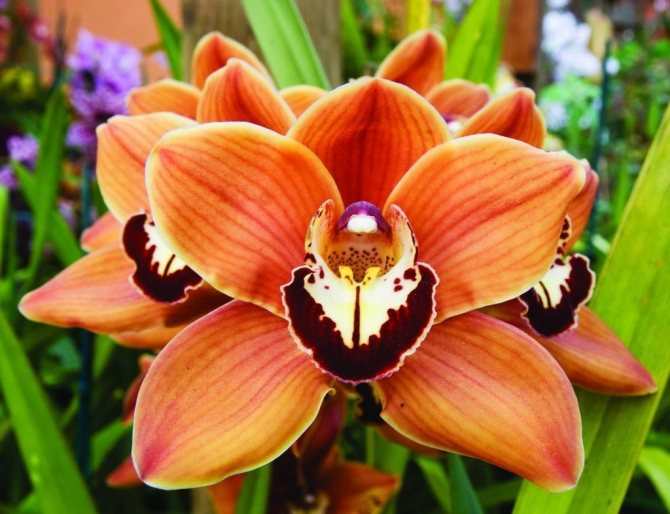

Why have cymbidium roots rotted and how to grow them to revive a flower
If the roots of the cymbidium have rotted partially or completely, this means that the plant has suffered from gray, black, brown or fusarium rot. Symptoms of diseases also appear on the outer part of the plant: brown and brown spots are noticeable on the petals, which grow rapidly, the leaves become covered with a watery spot, turn yellow, curl, die off.
Rot can also appear on potted soil. If such signs occur, you need to know how to reanimate the affected cymbidium: you should remove the plant from the substrate, examine the roots, remove all affected areas by sprinkling the sections with "Fundazol" or "Tetracycline".
It is also necessary to get rid of the rotten outer parts and transplant the orchid into a new flowerpot with a clean substrate. Watering must be reduced, since excess moisture provokes the development of rot, then sprinkle with "Fundazol", and as a preventive measure, once a month, treat the flower with copper sulfate.
If the roots of the cymbidium have almost completely rotted, then they can be increased. Experienced gardeners tell how to do this. According to them, the root mass of the flower is growing rapidly.
To do this, soak the remaining roots for 30 minutes in one of the solutions: 4 g of zircon per 1 liter of water or 1 g of succinic acid per 1 liter of water. Then you should plant the plant in a new pot (the size of which should be slightly larger than the root system itself), filled with the substrate, the composition of which was described above. At the bottom, you must not forget to lay out the drainage. Watering is allowed no earlier than the third day after planting, otherwise the root wounds will not have time to heal.
Cymbidium tracyanum ↑
- Flowers with a very pleasant aroma, yellowish-green with reddish spots. The lip is creamy, wavy along the edge.
- Inflorescence is a loose raceme with 15-20 flowers up to 12 cm in diameter.
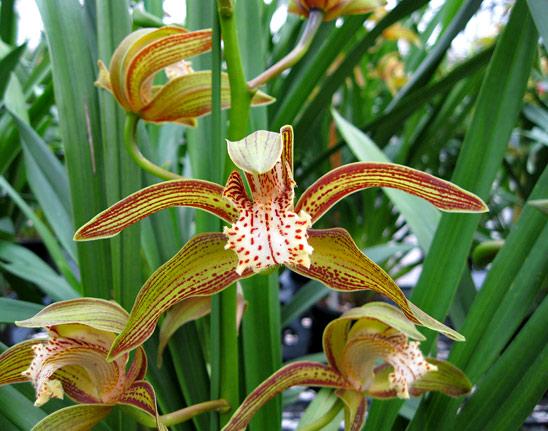

- The peduncle is more than a meter in length, straight or curved in an arc.
- Bloom from September to January lasting 2-3 weeks.
- Origin - Burma
Insect pests
The lower surface of the leaf blades and cymbidium buds are often inhabited by spider mites in dry air. Signs of their defeat are small white dots from the seamy part of the sheet and the appearance of cobwebs. The leaf loses color, turns gray and soon becomes brown and lifeless.
It is not difficult to determine the appearance on the leaves of the greenhouse flat beetle - the leaf plates are deformed, acquire a silvery-white color, small punctures are barely visible on their surface. During flowering, beet aphids parasitize on cymbidium buds.
Cymbidium lesions with mealybugs and scale insects are also not uncommon. On the leaves inhabited by parasites, miniature light yellow specks are formed, which eventually become depressed, brown, crimson-purple. These insects secrete honeydew, on which sooty fungi appear.
Cymbidium and thrips species - greenhouse and tobacco are found on orchids. It is difficult to notice them on an orchid, it is possible to judge their attack only by the characteristic silvery color of leaf areas with dark dots of excrement. Cymbidium transferred to the garden, slugs and snails bring considerable harm.
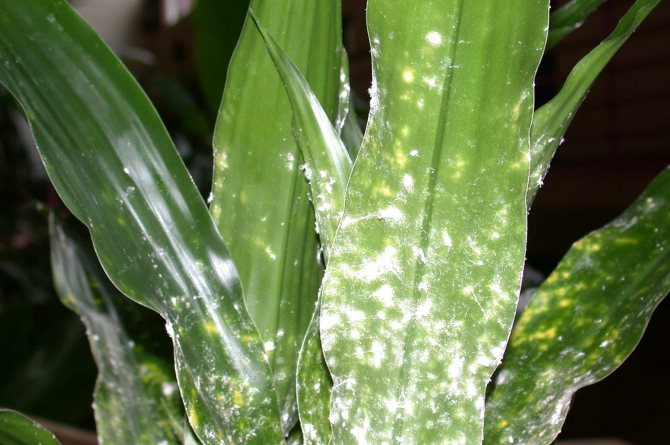

Mealybug on cymbidium orchids
History of origin and habitat
In nature, the flower can be found in:
- India;
- Japan;
- Vietnam;
- Thailand.
He prefers subtropical forests located at an altitude of more than two thousand meters above sea level.
The first description of this species was made in 1799 by naturalist Peter Olof Swartz.
In vivo, the Cymbidium orchid is an epiphyte... With its roots, it clings to cracks in stones or tree bark. Most often it can be found in hollows and on large branches.
reference... Cymbidium is a Greek word that means boat-like. The orchid got its name due to the structure of the "lip".
Possible difficulties
Sometimes flower growers are faced with the fact that the cymbidium does not bloom. The reason for this may be too high an air temperature. It should be lowered to + 20 ... + 22 ° C. It is equally important to provide nighttime cold snaps of 4-5 ° C. In order not to make too much effort to create the necessary temperature regime, in the spring and summer, the flowers are taken outside in a place protected from drafts and precipitation.
When kept in a cool room or stagnant water in the soil, the cymbidium suffers from rot. The appearance of mosaic spots on foliage indicates a viral disease. Swelling of the leaves may also develop, which is manifested by point growths on the leaf plate. It is almost impossible to save the affected plants. In the early stages of the disease, pruning of damaged parts, fungicide treatment and transplantation sometimes help. It is imperative to adjust the conditions of detention.
Periodically, flowers are invaded by spider mites, aphids and scale insects. In this case, you need to immediately carry out the insecticide treatment.
Pruning
Remove old wilted flowers regularly, as they speed up the process of wilting of new flowers by taking up nutrients. After the plant stops blooming, remove the peduncle as soon as possible: pull it towards you with a sharp movement, and it will break at a distance of 10 cm from the base.
It is very important that all pseudobulbs have enough light, including those in the middle of the bush. After flowering, remove a few leaves from the middle if there are too many. As in the case of the peduncles, for this it is enough to pull them sharply towards yourself.

